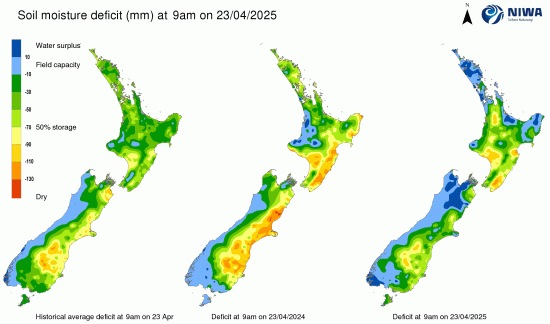
Here's our summary of key economic events overnight that affect New Zealand with news the impact of the inevitable looming inflation from the foolish American trade and tariff moves is sinking into investors and markets are in full risk-off mood today.
Wall Street is in sharp retreat, benchmark bond yields are sinking, spreads between US Treasuries and corporate bond yields are rising. Tech stocks are particularly hard hit with the Nasdaq down -2.6% to be nearly -4% lower for the week. In anybody's book, that is a big negative move.
Not helping is that the final University of Michigan March sentiment survey was revised lower from its already low 'flash result. Consumers are in full defensive mode, expecting inflation to jump, and job security to worsen. Wall Street can't ignore these signals.
Other data out today didn't help. The core US PCE inflation indicator for February rose its most since January 2024, and of course this doesn't include the effect of the recent policy missteps. The data is a little signal magnified by current policy settings.
US consumer spending came in lower than expected. Consumer savings rates rose. This is consistent with consumers shifting to a defensive mood ahead of their expected rough economic weather.
It isn't any better in Canada where their monthly GDP indicator for February revealed no net expansion, following a positive January expansion.
In Australia, they are off and running for their May 3, 2025 federal election. Like most elections, it will be fought on "cost of living" issues. The campaign starts with the incumbents in a strong and rising position on their two-party-preferred basis. Expect a sledge-a-thon for the next five weeks.
Worth watching is the price of copper. It is very high at present, but lower economic activity in both China and the US could bring about 'a collapse'. It would not be the only commodity to suffer.
We should also possibly note that the US Fed balance sheet shrunk again last week to be -US$745 bln lower than this time last year. So far we haven't seen any slacking in the pace of their tightening.
So far, the world has kept buying US Treasury paper, but the more the Federal finances are twisted by Trump, the less likely that demand will hold. But remember less than 24% of total US federal debt is held by foreigners (US$8.512 tln of US$36.218 tln in gross terms), so the impact is muted. However, markets will notice any substantial pullback by this group, and that will colour its market status and price.
The UST 10yr yield is now at 4.25%, down -11 bps from yesterday at this time. A week ago it was at this same level however. The key 2-10 yield curve is now at +34 bps. Their 1-5 curve is inverted by -6 bps. And their 3 mth-10yr curve is also now inverted by the same -6 bps. The Australian 10 year bond yield starts today at 4.46% and down -10 bps from yesterday. The China 10 year bond rate is now at 1.88% and up +1 bp. The NZ Government 10 year bond rate is now at 4.66%, and down -2 bps from yesterday. But that is +4 bps up on the week-ago level.
As we noted above, Wall Street is ending its Friday session in full retreat, down -2.0% on the S&P500. That is down -2.4% for the week. Overnight, European markets fell about -1.0% except London which only dipped -0.1%. Yesterday, Tokyo ended its Friday trade down -1.8% for a -1.9% weekly fall. Hong Kong was down -0.6% and Shanghai was down -0.7% for a -1.4% and -0.4% weekly drops respectively. Singapore was down -0.2%. The ASX200 ended its Friday trade up +0.2% for a weekly gain of +0.6%. But the NZX50 dipped -0.1% on the day to end its week up +1.4%, the best of the markets we follow.
The Fear & Greed Index ends the week staying in the 'extreme fear' zone, and unchanged from the past few weeks.
And we need to keep an eye on US P/E ratios. They have been high in an historical context, over 20x. Fear could shift this perception quickly.
Both Warren Buffett and Hong Kong's Li Ka-shing are hoarding cash right now. (But China is intervening to try and stop Li Ka-shing's cashing out of his Panama ports investment.)
The price of gold will start today at just on US$3080/oz and up another net +US$32 from yesterday. Although off it at the moment, gold keeps challenging its all-time high levels. A week ago it was at US$3015 so a +2.1% rise since then.
Oil prices are unchanged from yesterday at just over US$69.50/bbl in the US and the international Brent price is now just over US$73.50/bbl. A week ago they were US$68.50 and US$72 respectively.
The Kiwi dollar is now at 57.2 USc and down -10 bps from this time yesterday. A week ago it was at 57.4 USc. Against the Aussie we are down -20 bps at 90.9 AUc. Against the euro we are down -30 bps at just under 53 euro cents. That all means our TWI-5 starts today just over 66.7, and down -20 bps. That is where it was two weeks ago and is down -20 bps from this time last week.
The bitcoin price starts today at US$83,895 and down -3.5% from this time yesterday. However it has ranged between US$94,382 and US$78,498 in between. So volatility over the past 24 hours has been extreme at +/- 10.1%.
Daily exchange rates
Select chart tabs
The easiest place to stay up with event risk is by following our Economic Calendar here ».

16 Comments
The S&P500 rejection of the 200DMA (at 5,761) is an ominous sign.
Now the market probably retests 5,400, (though there are a few option expires that may help), if it drops through 5,400 models start selling again.
https://www.zerohedge.com/news/2025-03-29/warning-stocks-are-very-thin-…
some charts to illustrate the strong rejection of 200DMA and trendline.
Peak coal.
Coal prices are in the gutter. Newcastle coal futures have sunk to around $100 per ton, a far cry from the $450 highs we saw in 2022 during the post-invasion energy panic. This time, the culprit is less geopolitics and more good old-fashioned oversupply. India and China are pumping out record amounts of coal, which has sent prices skidding and stockpiles ballooning.
Glencore said in a Tuesday statement carried by Bloomberg.
No need to panic about peak coal.... peak wokeness makes it hard to extract however... even banking the miners is not fashionable
New Zealand has substantial coal reserves, estimated at over 15 billion tonnes, with a significant portion (80%) being lignite in the South Island, and the remaining coal resources being sub-bituminous and bituminous.
Here's a more detailed breakdown:
- 2023 Imports: New Zealand imported 240,305 metric tons of coal in 2023.
- 2022 Imports: In 2022, the country imported 726,838 metric tons of coal.
- 2021 Imports: In 2021, coal imports reached a record high of 1.8 million tonnes.
- 2020 Imports: In 2020, New Zealand imported approximately 1.084 million tonnes of coal, with 90% sourced from Indonesia and the rest from Australia.
"We think there are between three trillion and 23 trillion tonnes of coal buried under the North Sea," Dermot Roddy, former professor of energy at Newcastle University, told the Sunday Times. "This is thousands of times greater than all the oil and gas we have taken out so far, which totals around 6 billion tonnes. If we could extract just a few percent of that coal it would be enough to power the UK for decades or centuries.”
"A decade ago the talk was all about peak oil and gas but that has gone out of the window," he said. "The big game-changer is seismic imaging, which has become so sensitive that we can now pinpoint the ‘sweet spots’ where shale gas, oil and coal are to be found.
Energy companies previously deemed such stores inaccessible but technological advances such as gasification have allowed underground pumps to turn the coal into gas useful for power-generation.
"A decade ago the talk was all about peak oil and gas but that has gone out of the window,"
PDK in 3...2...1
needing oil for plastics to extract the endless supply of coal...
good thing we are heading for a Milankovitch low to help offset climate change
An interesting decade old quote....I wonder how expensive (both in terms of finance and energy) coal mined from the sea bed would prove to be?.... because if viable you may have just increased 'known' reserves 3-23 fold.
"...Not including the expense of carbon capture and carbon permits, the cost of coal gasification and the resulting power generation would amount to around 52 euros per megawatt-hour (44 pounds/MWh), according to a recent EC-funded report, compared with an estimated 48 euros per MWh from conventional gas power generation in Britain.
...The process was first adopted on a wide scale by the Soviet Union during the 1930s, but after the Second World War the technology failed to advance beyond the experimental stage because of cheap oil and gas prices."
https://www.reuters.com/article/business/energy/britain-seen-putting-of…
Do you not see the problem profile?....a decade after your links you still have nothing to invest in....why do you think that might be?
What problem? After a decade we are are awash with hydrocarbons. I'm not looking for anything to invest in but thanks for the tip.
"...This time, the culprit is less geopolitics and more good old-fashioned oversupply. India and China are pumping out record amounts of coal, which has sent prices skidding and stockpiles ballooning."
"...because of cheap oil and gas prices."
https://www.reuters.com/article/business/energy/britain-seen-putting-of…
During WW2 a lot of Allied bombing effort went into destroying Germany's synthetic petroleum production. Four tons of coal can produce a ton of petroleum.
I think people like PDK and Let me be Frank have too much emotion "invested" in this argument. There is an astonishing amount of hydrocarbon in the world. We don't invest a lot in it because there still remains vast and more accessible reserves.
Interesting about the development of pumps for use in coal gasification. PDK likes to write about Rome and how it ran out of resources. One of Rome's problems was the flooding of mines with water making it impossible to dig deeper. This problem was solved by English engineers and jump started the Industrial Revolution. Pumps are a very underrated technology.
Underrated by some...overrated by others. I expect you will be investing in North Sea Coal along with profile?
I recently posted about the Fed's GDPNow model for real GDP growth. In the space of two days, the measure fell to -2.8% from -1.8%
4 weeks ago it was +2.3%. 8 weeks ago it was +3.9%.
And even when gold adjusted, it is now negative.
Help, I have fallen and cannot get up.....


We welcome your comments below. If you are not already registered, please register to comment.
Remember we welcome robust, respectful and insightful debate. We don't welcome abusive or defamatory comments and will de-register those repeatedly making such comments. Our current comment policy is here.